 |
Relationship of Physical Science to Biology, Earth Science and Industrial Technology
Chemical principles contribute to the study of physics, biology (life sciences), agriculture,
engineering, medicine, space research, oceanography, and many other sciences. Chemistry
and physics (two of our physical sciences) are overlapping sciences, since both are based on the properties and behavior of
matter. Biological processes are chemical in nature. The metabolism of food to provide energy to living organisms is a chemical process. As each science grows more sophisticated, the boundaries become more blurred.
The chart below demonstrates that interrelationship:
(Flowchart goes here)
The flowchart begins with mathematics, as
should any science flowchart. You
cannot have science without mathematics. The blurring
of the sciences will not diminish the importance of math.
Environmentally
Friendly Family Entertainment Complex
Introduction
Family
entertainment complexes are establishments built for the purpose of providing low cost amusement for the entire family. Amusement facilities such as these usually have all or some of the following: video
arcades, batting cages, mini golf courses, go-kart tracks, and a restaurant. Examples
of family entertainment complexes within Northwest Indiana are the former Celebration Station and (to a certain
extent) Gary’s baseball stadium and the Genesis Center when the Steelheads are playing.
Environmentally friendly means that a particular human activity attempts to preserve or restore the natural
surroundings associated with that activity. An example of an environmentally
friendly endeavor is the Paul Douglas Environmental
Education Center on Lake Street in Gary. It is located in the Dunes National Lakeshore on land that
was once a railroad right of way. The land now has almost been restored to its
natural state. This year in our Science class, we will design the exterior, interior,
and “inner workings” of an environmentally friendly family entertainment complex.
Field Lab: Monitoring the air quality at Gary’s baseball stadium
Human
activity can cause air pollution, which consists of harmful materials that are added to the air. Pollutants can be gases or
particles. Air pollution can cause health problems and other damage. Can a particular
human activity also improve the quality of air in and around our environmentally
friendly family entertainment complex? We hope to answer this question with this
field lab.
The intention of this field lab is to observe and record the atmospheric discharge
from US Steel, Gary Works. The purpose is NOT to single-out US Steel, although
air pollution is often associated with steel production. The purpose is to observe
and record atmospheric pollution in general. What better place to do this
from if not from a great ballpark located blocks from a huge steel mill?
Actual observations made
-
1st Inning--level of wind low, no visible air
pollution, sun beginning to set
-
2nd Inning--level of wind diminished more,
still no visible air pollution, sky darker above sunset
-
3rd Inning--no shadows from sun, stadium lights
cast shadows, sky darker and darker
-
4th Inning--artificial light only, no stars,
pitch black sky
-
5th Inning--all observations same as 4th Inning
-
6th Inning--all observations same as 4th and
5th Inning
Note: We only stayed long enough to observe
six innings.
Now our student scientists will organize their observations
into a lab report beginning with the Four-Square method of paragraph designing. You should have one Four-Square for each inning.
Therefore, we should have six Four-Squares. Below is
a Four-Square example of the third inning. Notice how three of the squares begin as a third inning observation:
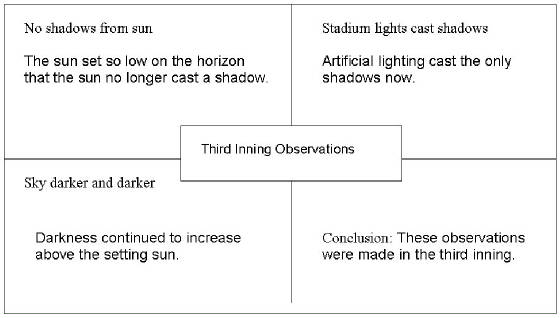
Lab
Report: Monitoring air quality at Gary’s
baseball stadium
The wind speed was obviously
low because the flags were not flapping much. Air pollution was not visible during
this inning. I could tell the sun was beginning to set because the shadows were
long. These are the things I observed in the first inning.
I can tell that the wind
diminished in speed even more because the flags practically stopped moving. Air
pollution was also not visible during the second inning. The sky became darker
above the setting sun. My second inning observations differed from my first inning
observations only slightly.
The
sun set so low on the horizon that the sun no longer cast a shadow. Artificial
lighting cast the only shadows now. Darkness continued to increase above the
setting sun. These observations were made in the third inning.
Not only does the artificial
lighting cast the only shadows, but this stadium lighting is the only source of
light. The night sky was starless. Not
even the moon was visible. A starless, pitch black sky could have been a result
of the intense artificial stadium lighting shining in our eyes. If there was
any air pollution present, then it may have been to dark to see it. Fourth inning
observations were more difficult to make because of the total darkness.
The tall stadium lights
were still the only illumination. There were still no stars in the night sky,
although one student observer claimed to see a single star (or planet). The bright
artificial ballpark lights still made the sky above the lights pitch black. Fifth
inning observations were practically the same as fourth inning observations because of the total darkness.
The tall stadium lights
were still the only illumination like in the previous two innings. There were
still no stars in the night sky visible with the naked eye. Bright artificial
ballpark lights still made the sky above the lights pitch black like. Sixth inning
observations were almost the same as fourth and fifth inning observations because of the darkness.
My overall conclusion is that a single example can never prove that something is always true, but it could
prove that something is not always
true. Our science class went to U.S. Steel Yard once to monitor air quality. We did not detect any visible air pollution therefore we cannot prove that it is always
true that U.S. Steel pollutes the air. We can prove however that it is not always true that U.S. Steel always pollutes the air because the day we went to the ball park, we did not
see any air pollution.
Earth’s
Changing Atmosphere
Human activities affect the atmosphere
Human activity can cause air pollution, which consists of harmful materials that
are added to the air. Pollutants can be gases or particles. Air pollution can cause health problems and other damage.
Human activities are increasing the amounts of greenhouse gases in the atmosphere.
Some greenhouse gases are carbon dioxide, water vapor, methane, and nitrous oxide. Temperatures on Earth have been rising.
Human activities produce CFCs and other chemicals that cause the destruction of ozone
in the stratosphere. However, smaller amounts of these chemicals are now being produced.
In the United States, the burning of fossil fuels in power plants, cars, factories, and homes is a major source of both air
pollutants and greenhouse gases.
Answer the following key concept questions:
1.
Describe two of the sources
of air pollution.
2.
What are three human activities
that increase the levels of greenhouse gases?
3.
What human activities affect
the ozone layer?
Earth’s waters circulate in the water cycle
The water cycle is the continual movement of water through the environment of Earth. The processes of the water
cycle are:
- evaporation, in which water changes from liquid to vapor
- condensation, in which water changes from vapor to liquid
- Precipitation, in which liquid water falls from the atmosphere to Earth's
surface
As water moves in the water cycle, the total amount of water in Earth's system does not change very much.
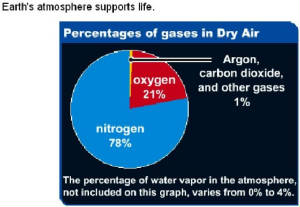
- The atmosphere is a thin layer that surrounds Earth. It is made of a mixture
of gases and particles.
- The atmosphere makes life on Earth possible. Gases keep Earth warm, transport
energy from place to place, and provide materials necessary for living things.
- The atmosphere is less dense at higher altitudes.
- Materials move into and out of the atmosphere in cycles.
- Dramatic events (such as volcanic activity) may also move material into the
atmosphere.
Answer the following key concepts in complete sentences:
1) How is the atmosphere important to living things?
2) What substances make up air?
3) How can the outside vegetation from our environmentally
friendly family entertainment complex improve the quality of air?
4) Draw a diagram using AutoShapes to show how one
of the natural cycles illustrated in class affects the atmosphere.
| Sun supplies the atmosphere's energy |
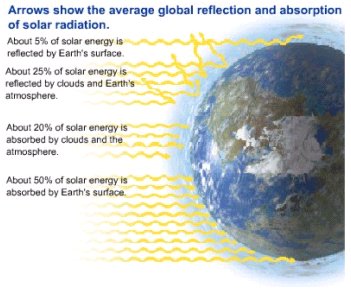
|
The sun supplies
the atmosphere’s energy. The atmosphere gains, moves, and loses energy
through radiation, conduction, and convection. Solar radiation warms Earth's
surface. The ground warms the air that touches it through conduction. Energy moves upward through convection as warm air is pushed upward by cooler,
denser air.
The atmosphere has layers that are defined by whether the temperature increases or decreases with altitude within
the layer. Two examples are:
- In the troposphere, the layer nearest the surface, the temperature decreases
as you go up.
- In the stratosphere, which is above the troposphere and contains ozone, the
temperature increases as you go up.
Answer the following
Key Concepts in complete sentences:
1.
What two things happen to solar
radiation that reaches Earth (Hint: use the graphic above to help answer this question)?
2.
Describe the three processes
that transport energy.
3.
Draw a conclusion. How might a thick, puffy cloud reflect a different amount of the Sun’s radiation, than a thin wispy
one?
4.
Jet planes fly toward the top
of the troposphere. Is it more important to heat or cool the passenger cabins?
Explain your reasoning.
Gases absorb and emit radiation in our atmosphere
Ozone in the stratosphere absorbs harmful ultraviolet radiation before it reaches Earth's surface. Therefore, depletion of our ozone layer is harmful to life on earth.
Greenhouse gases within the atmosphere (in the troposphere) absorb some of the infrared radiation that is emitted by
Earth's surface. These gases (much of which is carbon dioxide) also emit infrared
radiation. This process, called the greenhouse effect, slows the loss of energy from Earth and keeps Earth warm. Therefore, excessive burning of fossil fuels (which puts even more carbon dioxide
into our atmosphere) can cause global warming. Our environmentally friendly family
entertainment complex will limit the use of fossil fuels as a power source as much as possible.
Answer the following key concepts in complete sentences:
1.
Name and describe two ways
gases can affect radiation.
2.
What type of radiation does
the ozone layer affect?
3.
How do greenhouse gases keep
Earth warm?
Chemical reactions take place inside
cells
All cells are made of the same 25 elements essential for life. The most common six are:
- Oxygen
- Carbon
- Hydrogen
- Nitrogen
- Calcium
- Phosphorus
Almost all of the elements essential for life exist in the cell as compounds and molecules, or substances made
of two or more elements. Most activities that take place in a cell are chemical reactions involving compounds, molecules,
and atoms. These reactions provide and use up chemical energy to support the cell.
There are four main types of large molecules that support cell function.
- Carbohydrates provide the cell with energy. Simple carbohydrates are sugar molecules. Long
chains of sugar molecules form more complex carbohydrates, such as starch and cellulose.
- Lipids provide energy and give structural support. Fats, oils, and waxes are lipids.
One unique property of lipids is that they cannot mix with water. This arises from the structure of lipid molecules.
- Proteins carry out most of the chemical activity in cells. Cells build proteins from
smaller molecules called amino acids. Proteins make up parts of the cell membrane, help deliver oxygen to other cells, and
help control chemical reactions in the cell.
- Nucleic acids store and translate the instructions for the maintenance, growth, and reproduction
of a cell. Nucleic acids are made of smaller units called nucleotides. There are two kinds of nucleic acids: DNA and RNA.
About two thirds of every
cell is water. Water is a polar molecule, meaning that one end has a slight negative charge, while the other end has a slight
positive charge.
Cell membranes are formed from a double layer of lipids that separates
the inside of a cell from the outside. The cell membrane has water-loving heads
facing out and water-hating tails facing in. Water cannot just move through the
membrane. The water-hating, or nonpolar, tails repel water molecules. This keeps the water inside the cell and outside the
cell separate.
Answer the following key
concepts in complete sentences:
1.
What functions do proteins, carbohydrates, lipids, and nucleic acids
perform?
2.
Which of the large four molecules that support cell functions carries
out most of the chemical activity in cells?
3.
What does it mean to describe water molecules as being polar?
4.
How are carbohydrates and lipids similar? How are they different?
Cells capture and release energy.
All cells need chemical
energy stored in carbohydrates. A major source of stored energy for most cells is the simple sugar molecule glucose. Plant cells capture light energy and convert it into stored chemical energy through
photosynthesis.
The starting materials
for photosynthesis are carbon dioxide and water. The plant gets carbon dioxide from the air and water from the ground. Carbon dioxide and water enter chloroplasts, the special cells that contain chlorophyll,
a light-absorbing pigment. Chlorophyll absorbs energy from the Sun. This energy is used in a chemical reaction with carbon
dioxide and water. The end products of the chemical reaction are glucose and
oxygen. The plant releases most of the oxygen back to the air and stores the glucose for energy.
The plant does not use
all the glucose it makes. What is not used immediately is stored as the complex carbohydrate starch. Animals can eat the plants
to get the stored starch energy, or eat other animals that have eaten plants. All
cells release energy from glucose in two basic processes: cellular respiration and fermentation.
Cellular respiration uses oxygen to break down glucose into carbon dioxide
and water:
The starting materials
for cellular respiration are glucose and oxygen. Glucose is broken down into
small pieces in the cytoplasm, which releases a small amount of energy. The pieces of glucose along with oxygen then enter
the mitochondria as the pieces are broken down further by a chemical reaction, they release large amounts of energy. The end products of the chemical reaction are energy, carbon dioxide, and water. The
cell releases the carbon dioxide. The energy that the cell does not use is released
as heat.
Fermentation breaks down glucose without oxygen. Fermentation starts the same way as cellular respiration. Glucose is broken down into small pieces in the
cytoplasm, which releases a small amount of energy. The pieces of glucose are
broken down further in the cytoplasm, which again releases a small amount of energy.
The products of alcoholic fermentation are alcohol and carbon dioxide. The product of lactic acid fermentation is lactic
acid. Food products such as bread, yogurt, and cheese are made using the process
of fermentation.
Muscles in the human body
are able to release energy by both cellular respiration and fermentation. However, muscles need to recover from the process
of fermentation. Muscles burn after a lot of exercise from the buildup of lactic acid; the burn goes away after enough oxygen
has returned to the muscles to break down the lactic acid.
Answer the following questions
in complete sentences:
1.
What starting materials do cells need for cellular respiration?
2.
How are photosynthesis and cellular respiration similar? How are they different?
3.
Suppose that in a lab you could remove all the oxygen from a terrarium. What would happen to the plants? Why?
4.
In everyday language, respiration refers to breathing. How is breathing related to cellular respiration? Hint: The
air we breathe out contains more carbon dioxide than the air we breathe in.
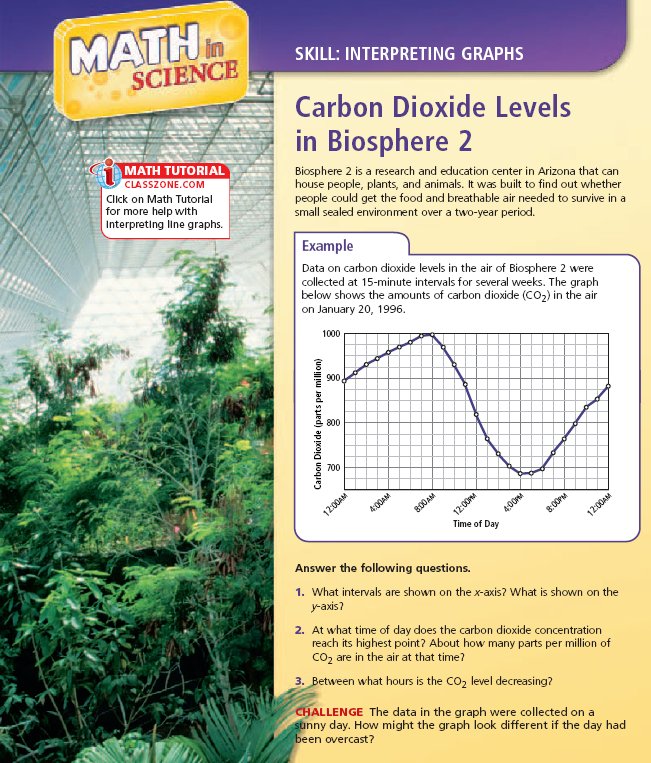
|
| Answer all of the above the questions |
| Use Four-Square for Challenge question |
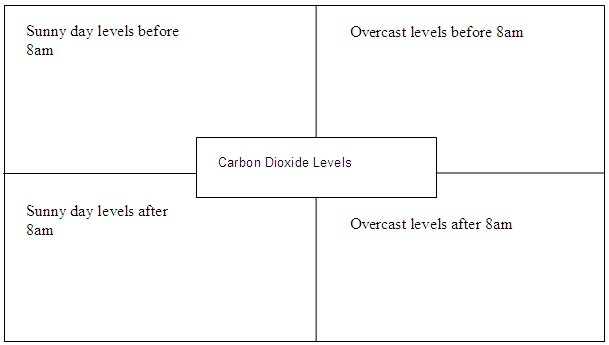
|
| Format your Challenge answer with the Four-Square above |
Graphing Data That We Collected
Our science
class will use three different types of graphs this year for displaying data: line graphs, circle graphs, and bar graphs. Line graphs most appropriately compare data over a period of time. Circle graphs display data as a percentage of the whole (100%).
Often circle graphs are called pie charts because the percentages of a whole look like slices of a pie. Bar graphs are most appropriately used to compare data items to other data items during the same
time period.
Before we can make a graph, we must organize our data. One
of the best ways of organizing data is to make a data table. The table below
is the actual information we collected September
29, 2004:
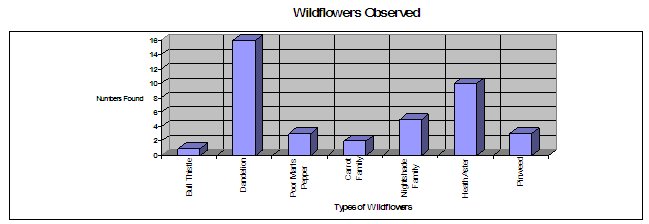
|
| This bar graph was made from the data table above. |
Cell division occurs in all organisms
Unicellular organisms reproduce through
cell division. In multicellular organisms, cell division performs many functions. Eukaryotic
cells of multicellular organisms have a nucleus. The nucleus contains most of the genetic information, and that information
is organized into chromosomes.
DNA stands for deoxyribonucleic acid.
It is made of two strands of nucleotides joined in a structure that resembles a twisted ladder, or a double helix. Most of the time, DNA is a mass of loose strands in the nucleus so it can be copied. Before the cell divides,
though, the DNA wraps around proteins and compresses. These compacted DNA structures are called chromosomes. Each organism
has a specific number of chromosomes that form every time a cell divides. For example, humans have 46 chromosomes, while corn
has 20.
The functions of cell division in multicellular
organisms are growth, development, and repair:
Growth--An organism
grows by adding cells. As a cell divides, one becomes two. When those two cells divide, two become four. Larger organisms
have more cells than smaller organisms. An adult has more cells than a child. However, once an organism becomes an adult,
cells still keep dividing but with different functions.
Development--Soon after
an embryo forms, cells specialize as they divide. They take on shapes or structures to perform particular functions. Some
cells may be layered skin cells. Other cells might become long, thin nerve cells.
Repair Cells--reproduce
to repair injuries, like a cut or a burn. They also replace dead cells. Different cells are replaced at different rates though.
Skin cells are constantly replaced. Cells in your brain are rarely replaced because they live a long time.
Answer the following key concepts in
complete sentences:
1.
Why is cell division important?
2.
How is genetic material organized in eukaryotic cells?
3.
Explain how cell division is involved in the growth, development, and repair of an organism.
4.
Why do you think that injuries to the skin generally heal faster than injuries to the brain?
Cell division is part of the cell cycle.
The cell cycle is the normal sequence of development and division of a cell. There are two
main phases: one in which the cell carries out functions and one in which the cell divides.
Interphase is the part of the cell cycle during which a cell carries out normal life activities.
These activities include transport and cellular respiration. The cell also grows in size, and DNA is duplicated during this
phase. Mitosis is the part of the
cell cycle during which the nucleus divides. Only eukaryotic cells go through mitosis; prokaryotic cells divide genetic material
differently. Cytokinesis is the division
of the cytoplasm immediately after mitosis. Once complete, two genetically identical,
but smaller, daughter cells are formed. Both will function the same as the parent cell. They are also genetically identical
to the parent cell.
Although mitosis is a continuous process, scientists divide the events of mitosis into four phases:
Ø During prophase,
the chromosomes form. Chromosomes consist of two chromotids held together by a centromere. The chromotids are exact copies
of each other. The membrane around the nucleus also disappears during this phase.
Ø During metaphase,
the chromosomes line up in the middle of the cell.
Ø During anaphase,
the chromosomes separate and are pulled to opposite sides of the cell.
Ø During telophase,
a nuclear membrane forms around each group of chromosomes. The DNA returns to a loose mass of strands.
Cytokinesis (division of the cytoplasm) differs slightly in animal cells and plant cells. In animal
cells, the cell membrane pinches in until a membrane forms around each cell. In plant cells, a cell plate grows between the
two new nuclei. The plate develops into a membrane and becomes part of the cell wall of each new cell.
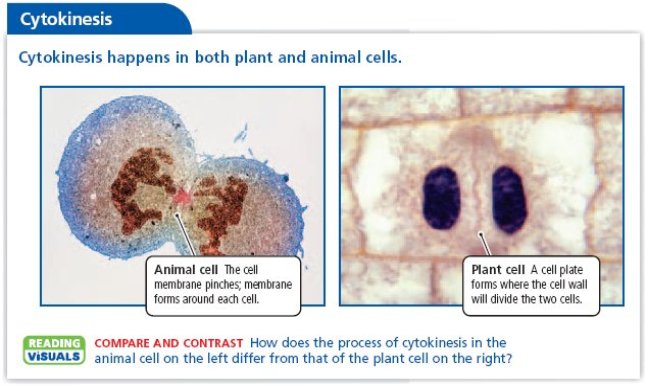
1.
Answer then draw the above
examples of cytoplasm division.
2. Describe the state of a cell about to start mitosis.
3.
What are the two main parts
of the cell cycle?
4.
Describe in order the steps
that occur in mitosis.
Chemical
Interactions: How Ice Cream is Frozen
A solution is a type of mixture, called a homogeneous mixture, that is the same throughout. Although
the parts of a solution can be physically separated, all the portions of a solution have the same properties. If you've ever
mixed sugar and water, you've made a solution. All solutions have definite components.
Solute is a substance that is dissolved to make a solution. In the case of sugar water, sugar would be the solute.
Solvent is a substance that dissolves the solute. In the case of sugar water, water is the solvent. In general, the substance
present in greater amount is the solvent. Water is the most common solvent.
Lowering the Freezing Point
The freezing point of a liquid solvent decreases when a solute is dissolved
in it. Pure water, which freezes at 0°C (32°F) under normal conditions, will freeze at somewhat lower temperatures when a
solute is dissolved in it. This is the reason why salt is often placed on icy roads: it lowers the freezing point of the water
and causes the ice to melt. There is a limit to how far a solute can reduce the freezing point of the solvent, however. Water
will always freeze at -21°C (-6°F).
Vocabulary
1. Solution
2. Solvent
3. Solute
Complete
the four-squares below and write a brief essay on the vocabulary words by combining the four-squares into complete sentences,
then paragraphs.
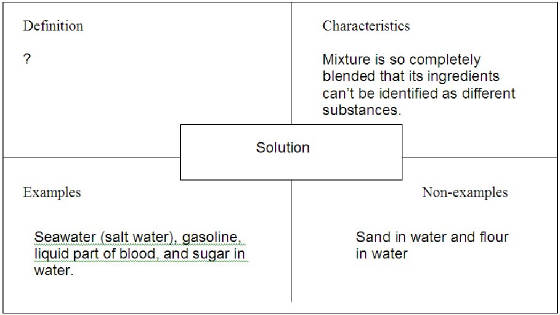
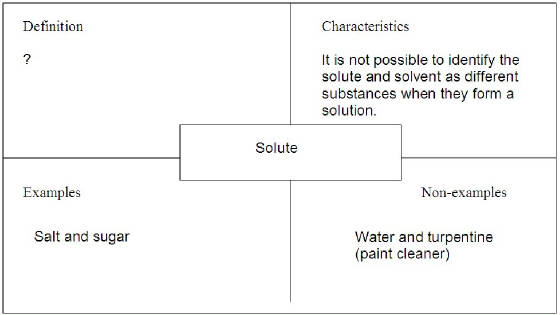
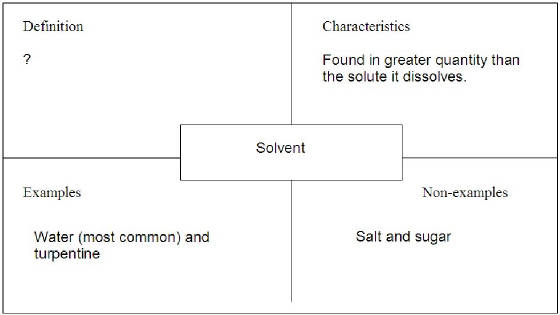
Energy Transformation Lab: Counting Calories
• When you eat, you add energy to your
system by adding material that can release potential energy via chemical reactions.
We often measure that energy in a unit called a calorie.
• The calorie values given on the nutrition
facts for different types of food, then, represent the amount of energy (potential energy) that these foods can release when they are digested and metabolized.
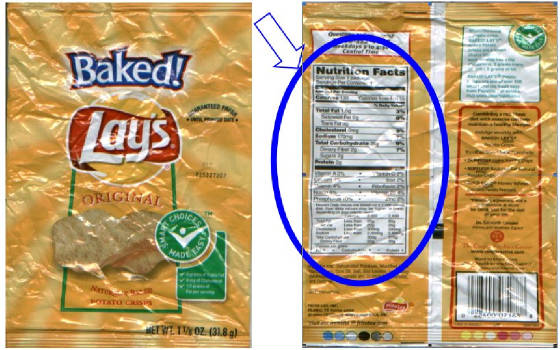
• Our bodies are constantly transforming energy stored
in various ways within the body, including the formation of fat cells. When we do physical work, for example, we can transform mechanical
energy into heat energy (commonly known as burning calories). Thus when you count calories, you are counting energy intake. If your output is less than your intake,
then you will gain weight. However, if your intake is less than your output, then you will lose weight.
• If the average professional basketball
player burns 70 calories for each minute played, then how many calories will that player
lose during an entire game?
•Example of data table
(above). •Please make sure that you allow enough
rows for all of the players.
•Determine how many servings of each listed snack item each player will have to consume to replace calories lost during
the game.
•Also answer the following questions in your lab report: Which snack foods provide the most calories with the least
amount of servings? Least amount of bulk?
•Example of data table (Mister Parr's data table is given below)
needed to display results for each player.
Player's Name:
Mister Parr
Calories Burned: 3360
|
Snack Item |
Calories per serving |
Oz. per serving |
Servings @ Total Calories |
|
Flaming
Hots |
190 |
1 1/8 oz |
17.68 @
3360 |
|
Cheetos
Crunchy |
180 |
1 1/8 oz |
18.67 @
3360 |
|
Chocolate
Milk |
160 |
1 cup |
21 @ 3360 |
|
Vitner’s
Cheese Kurls |
140 |
1 1/8 oz |
24 @ 3360 |
|
Reese’s
Peanut Butter Cups |
230 |
2 peanut
butter cups |
14.61 @
3360 |
|
Fudge Brownies |
280 |
2 |
12 @ 3360 |
|
Nabisco
Strawberry Fruit Snacks |
90 |
2.5 oz |
37.33 @
3360 |
The Scientific Inquiry: Energy Transformation Lab
Although you might not know it, your thinking and questioning is the start of the scientific inquiry process
(also known as the scientific method). Scientific inquiry refers to
the diverse ways in which scientists study the natural world and propose explanations based on the evidence they gather.
1.
Posing Questions. Scientific inquiry often begins with a problem or question about an observation. In the case of our energy transformation lab, our question will be:
Is there a direct relationship between the snack item serving size and the calories per serving?
2.
Developing a Hypothesis. A statement as to the answer of a possible scientific question. In our case, the hypothesis would be that the number of calories per serving directly relates to the size
of the serving. Many trials will be needed before a hypothesis can be accepted
as true.
3.
Design an Experiment. To test our hypothesis, we will need to observe calories per serving at various serving
sizes. In a controlled experiment, one variable that is purposely changed to
test a hypothesis is called the independent variable or manipulated variable.
In our energy transformation experiment, the number of calories will be manipulated.
The factor that may change in response to the independent variable is called the dependent variable. The dependent variable here is the size of the servings.
4.
Collecting and Interpreting Data. Before we begin our experiment, we should make a data table in which
to record our data.
5.
Graphing Your Results. After all data have been collected, then it needs to be interpreted. Graphs can reveal patterns or trends in data.
6.
Drawing Conclusions. A conclusion is a summary of what you have learned from an experiment. In drawing your conclusion, you should ask yourself whether the data supports the hypothesis.
7.
Communication. An important part of the scientific inquiry process is communicating your results. Communicating is the sharing of ideas and experimental findings with others through writing and speaking. A common way we communicate like this in the Gary School Corporation is through the
use of Science Fairs.
Instructions: Make a science fair project
based on our Energy Transformation Lab. Use the scientific inquiry process above
to design your project. Your hypothesis should be: Total calories directly relates
to the total weight of servings.
The
immune system defends the body
Define these terms (go to textbook, Human Biology, Chapter 3 vocabulary):
- Antibodies
- Antigens
- Pathogen
The body has three lines of defense
against pathogens (disease causing agents). The first line of defense,
the surfaces of the skin, breathing passages, mouth, and stomach function as barriers to pathogens. What happens if one of our basketball players takes a fall, gets injured, and then breaks his or her skin?
Pathogens
that DO get into your body can trigger the inflammatory
response, the body’s second line of defense. In the inflammatory response,
fluid and white blood cells leak from blood vessels into nearby tissues. The
white blood cells then fight the pathogens. During the inflammatory response,
the affected area becomes red, swollen, and warm.
The immune response is the body’s
third line of defense. T cells and B cells are the two major types of white blood
cells that produce the immune response. T cells identify and distinguish between
pathogens because they recognize a marker called an antigen, which is carried by each pathogen. After the T cells recognize an antigen, B cells are signaled to make chemicals called antibodies
to destroy the pathogen. Each kind of B cell produces an antibody which can only
bind to one kind of antigen. Once the binding occurs, the pathogen is marked
for destruction.
Read for understanding. Make a chart of the body’s three lines
of defense:
|
First line of defense |
Second line of defense |
Third line of defense |
|
|
|
|
Key Concepts about Dams and Fresh Water:
Dams are important structures for human use of fresh water. A dam
can hold back the water of a river or another body of water. In a hydroelectric
dam, water is released through the dam. As the water flows, it turns machines that generate electricity.
- Dams can also help with transportation. They can slow down a river that runs
too fast. They can also have locks, which allow boats to move to different sections of a river with higher or lower elevations. A lock is a section of waterway, closed off by gates, in which the water level
is raised or lowered to move ships through.
- Dams greatly change the river environment. A body of water created behind
a dam is a lake called a reservoir. The reservoir can provide a large source of fresh water for people to use.
- Dams can also create problems. The Aswan Dam in Egypt, which used to flood into the Nile River valley every year, blocks rich sediment. Farmers must now use chemical fertilizers
to grow crops rather than using new, fertile soil.
Lab: A Scale Model of A Flood Bank
This model will be used to determine what impact building a dam will have on the local river environment.
Observations:
1.
What effect does a dam
have on a natural river environment?
2.
Which volume of water
flow has the greatest impact on the formation of geologic features?
3.
Is it possible to maintain
a healthy river environment downstream from a dam?
4.
Why or why not?
Fresh Water Resources
Fresh water held underground is called groundwater. Surface water
sinks into the ground, which is composed of different types of materials. Permeable materials are materials which contain
spaces within them or between their particles. Water can flow through the spaces. Soil, sand, gravel, and some types of rock
are permeable materials. Impermeable materials are materials which have
no spaces or very small overlapping spaces. Water does not flow through impermeable material. Clay and granite are impermeable.
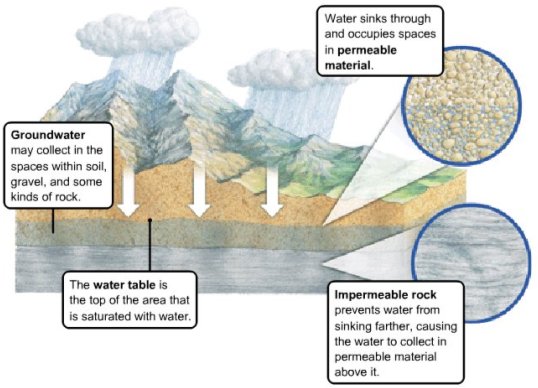
Water sinks into the ground and fills the spaces available in the permeable material until it reaches
impermeable material. The water table is the top of the water-filled permeable
material. An aquifer is an underground region of permeable material that contains
water. Aquifers are used by people as a freshwater source.
Springs are flows
of groundwater where the land is lower than the water table. Wells are
holes dug into the ground. The holes reach down below the water table. Generally a pump is used to bring the groundwater up
to the surface. Artesian wells are natural formations in which water can flow upward because of pressure on it.
Fresh Water Supports Life
People
have always lived near clean, fresh water. One reason why water is so important
is because our bodies are more than one-half water. Without the water in your
blood, your cells would not receive the nutrients they need. Without water, a
person cannot live for more than a few days. Without water, people would not
be able to grow food. In the United States, 40% of the water that is used goes to growing crops
and raising livestock. The process of humans supplying water to land to grow
crops is irrigation.
Society
depends on clean and safe water. Drinking water comes from many different sources
and can contain impurities and organisms that cause disease. Drinking water is treated to make sure it is safe. Wastewater, water that runs down the drain, is treated before it is released back into the environment.
Wastewater is treated two ways:
Sewage systems collect and treat wastewater from towns and cities. The wastewater goes through two steps that
remove sludge, grease, and bacteria. The water from the system is then safe to put back into the environment.
Septic systems collect and treat wastewater from homes or businesses. The wastewater flows into a tank where heavy
material settles to the bottom and much of it is consumed by bacteria. The water from the system is cleaner and can go back
into the ground. Sometimes human activities add far too many minerals, chemicals,
or organisms to the water supply to be treated. The water supply becomes polluted. Pollution can come from two sources:
Point-source pollution enters the water from a known source, such as chemicals from a factory. This pollution is easy to spot,
and laws can be enforced to stop it.
Nonpoint-source pollution is hard to find or is scattered, such as run-off from farms and lawns that goes into a river or stream.
This pollution is not easy to spot, and it is hard to enforce laws against it.
Complete the Four-squares below:
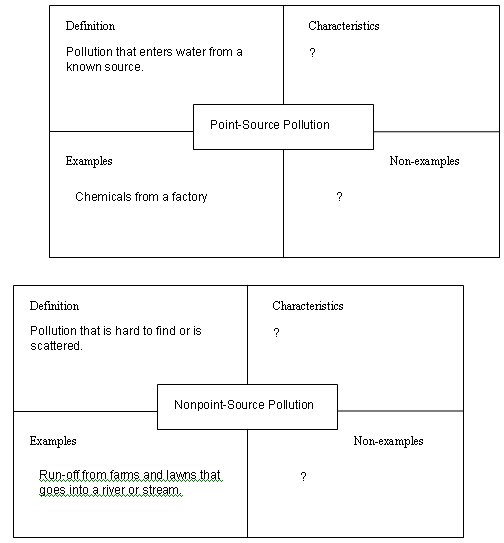
|
| Replace the question marks with your text |
Earth has been home to living things for about 3.8 billion years.
Fossils
provide evidence about the history of life on Earth. Most fossils are hard body parts or bone. Others form when minerals replace
the remains of organisms. Fossils also include prints left by organisms, such as footprints. Very rarely, a fossil is the
preserved remains of an organism, such as a wooly mammoth in ice or an insect preserved in sap.
Relative age is how old a rock or fossil is compared
to other rocks or fossils. Ancient organisms settled to the bottom of a body of water in layers of mud and sand that later
formed rock. A fossil found in a deeper layer of rock is usually older than a fossil found in a layer of rock near the top.
Absolute age is the actual age of the rock or fossil.
To measure the absolute age of a fossil, scientists measure its radioactivity. Over time, radioactive material disappears.
The older the fossil, the less radioactive material it has.
The
fossil record is all of the information that can be gathered from the fossils
in a particular location. Scientists can then use the record to identify which species lived and died during different periods
of time.
More complex organisms developed over the course of Earth's history.
Unicellular organisms, made of only one cell, were
the first living things on Earth. They appeared about 3.8 billion years ago. The atmosphere then did not have as much oxygen
as it does now. Some of the early organisms added oxygen to the atmosphere.
Multicellular organisms began to live in Earth's oceans
about 1.2 billion years ago. Multicellular organisms have many cells that perform different tasks within the same body. The
fossil record shows that the earliest multicellular organisms were tiny seaweeds. The earliest animals were similar to jellyfish.
Life
appeared on land about 500 million years ago. Before that, all living things met their needs while living in water. Simple
plants were the first land-dwelling organisms, getting water from the soil through roots. The plants in turn provided food
and shelter to the first fungi and insects on land. After insects, amphibians and reptiles began to live on land, followed
by birds and mammals.
A species
becomes extinct when all members of the species have died. Many species have only been seen as fossils because they became
extinct long ago. A mass extinction is a period when a large number of species become extinct in a very short time.
v The Permian Extinction occurred about 250 million years ago. Approximately 90 percent of the species in the ocean,
as well as many land-dwelling animals, became extinct. This mass extinction may have been caused by climate change due to
all of Earth's landmasses joining together to form a single, enormous continent.
v The Cretaceous Extinction occurred about 65 million years ago. More than half of all the species on Earth, including
dinosaurs, became extinct. This mass extinction may have been caused by a meteorite, a giant space object, colliding with
Earth.
v Mass extinctions are often followed by the appearance of a large number of new species. For example, the extinction
of dinosaurs may have allowed new species of mammals to develop and thrive.
Answer the following key
concept questions in complete sentences:
1. How do fossils help scientists understand the history
of life?
2. How do scientists know that the first organisms were
simple, unicellular organisms?
3. What is extinction? Give an example of mass
extinction and its results.
4. How do absolute dating and relative dating help scientists
assemble a fossil record for an area?
5. Draw a timeline showing the sequence of three major
events in the history of life. Include the following terms on your timeline: unicellular, multicellular, ocean, and
land.
Evolution is the process by which species change over time.
In
the early 1800s, Jean-Baptiste de Lamarck proposed a theory of evolution. He suggested that organisms develop traits during
their lives and then pass them on to offspring. For example, a giraffe stretches its neck to get high leaves, and then passes
that longer neck to the next generation. But Lamarck could not find evidence to support his theory.
Charles
Darwin was a naturalist who traveled to the Galapagos Islands in the
late 1830s. Darwin's theory of evolution developed from observing different species of tortoises and finches on the Galapagos Islands. For example, he found some
finches with beaks useful for cracking seeds and others with beaks useful for capturing insects. Darwin wondered whether the birds
had evolved differently because they were in different environments.
A group of organisms may evolve due to artificial selection or natural selection.
Artificial
selection is the process that breeders use to produce animals with desirable traits.
A breeder will select individuals with desired traits from a group, then allow only those individuals to mate. In the next
generation, the breeder will again select the individuals with desired traits and mate them to produce the next generation.
Natural
selection is the hypothesis Darwin developed based on his observations from his
voyage and from his hobby of breeding pigeons. Darwin proposed that members of a species that are best suited to their environment survive and reproduce
at a higher rate than other members of the species. This process is called natural selection.
The
process of natural selection depends on a few key principles:
An
adaptation is any inherited trait that gives an organism an advantage in its particular environment. An adaptation
is a variation that makes an individual better able to survive than others. For example, a slight change in the shape of a
fin might make a fish swim faster and avoid predators.
Selection is the process that passes the most successful variations, or adaptations, into the next generation.
Of the organisms that then survive to reproduce, more and more of them will have the adaptation. The favorable traits are
"selected" for the next generations. In this way, the species as a whole becomes more suited to its environment.
Speciation is the evolution of a new species from an existing species. Speciation can occur when the environment
changes. When genetic changes within two groups of the same species build up, the two groups may not be able to interbreed
anymore. When this happens, two different species have formed and speciation has occurred. The diagrams show how three species
of cichlid fish evolved from one original species in Lake Tanganyika.
Isolation is essential to speciation. For a species to separate, two groups must be prevented from reproducing
with one another. A geographic boundary, such as a mountain range or ocean, can result in isolation. The cichlids in Lake Tanganyika and the finches Darwin observed in the Galapagos Islands are examples of isolation
leading to new species.
Answer the following key
concepts in complete sentences:
1.
How did Lamarck’s ideas differ from Darwin’s?
2.
Explain how isolation helps speciation.
3.
Two species of grasses are separated by a tall mountain range. A third species of grass shares some characteristics with each of the other two species. It inhabits a small valley, surrounded on all four sides by mountains. Form a hypothesis for the origin of the third species.
4.
The Artic hare lives in snow-covered mountains in Canada. The hare is hunted by foxes, wolves, and owls. Which trait
is more likely to be inherited by new generations of hares: white fur or black fur?
Explain.
Many types of evidence support evolution.
A theory is a widely accepted statement, based on scientific evidence, that helps
explain a group of facts. Darwin's theory of evolution is widely accepted because it is supported by fossil evidence, biological
evidence, and genetic evidence.
Evidence from fossils supports
evolution. An ancestor is an early form of an organism from which later forms descend. According to the theory of evolution,
different species should have common ancestors. Fossil evidence supports this idea. For example, modern plants and modern
algae share characteristics with fossil algae that point to a common ancestor.
Biological evidence supports
evolution. Biological evidence includes the structure of living things and how living things develop into adults.
Vestigial organs are physical structures that were fully developed
and functional in an earlier group of organisms but are reduced and unused in later species. These vestigial organs indicate
that the organism had an ancestor that needed the trait, and can show how the modern organism and the ancestor are related.
Similar structures with different functions indicate that organisms
shared a common ancestor. For example, the illustrations show that geckos, bats, and manatees have similar bones in their
forelimb. A shorter bone leads from the shoulder to a joint. From the joint, the longer bone leads to a wrist. Because the
three organisms live in very different environments, the similar structures have evolved in very different ways.
Similarities in development of different species that are unlike as adults indicate a common ancestor. For example, a chicken, a rabbit, and a
salamander are three very different animals. However, their embryos look very similar. As the embryos develop, they become
more different. This evidence indicates that many animals must share a common ancestor whose embryo started developing in
a similar way.
Genetic
evidence supports the theory of evolution.
DNA contains the genetic material found in all cells. It contains a
code that a cell uses to function properly. The code is a pattern of four chemical units called bases, represented by the
letters A, T, C, and G.
Genes are segments of DNA that relate to a specific trait or function
of an organism. For example, the clock gene is found in many mammals and relates to how the mammal sleeps and wakes. The clock
gene can be used to compare different organisms. The more similar the code is for the clock gene between two organisms, the
more closely related the two organisms are.
Answer the following key concepts in complete
sentences:
1.
Describe in your own words how scientists use the word theory.
2.
What type of evidence did Darwin use to support his theory of evolution?
3.
Identify three different types of evidence that today’s scientists
use to support evolution.
4.
Describe three characteristics of a scientific theory. Explain how Darwin’s theory of evolution is an example of a scientific theory.
| Water Falls to Earth as Precipitation |
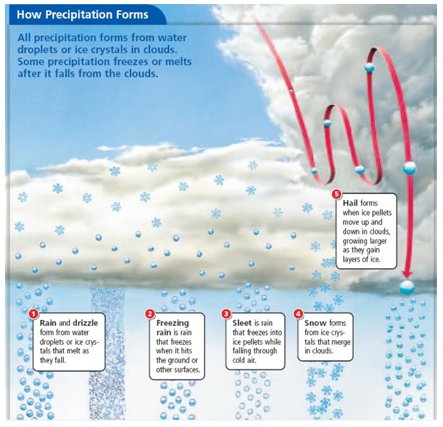
|
One way that precipitation can form is
through the combining of cloud droplets. The tiny droplets of water move up and
down in clouds. Some collide with each other and combine, forming slightly bigger
droplets. Eventually they become heavy enough to fall. It takes about a million droplets to make a single raindrop.
Another
way that precipitation can form is through the growth of ice crystals. If the
temperature inside a cloud is below freezing, water vapor changes into tiny ice crystals.
These crystals grow by collecting more water vapor or by colliding and merging with one another. The crystals fall from the clouds when they become heavy enough.
Most rain in the United States actually starts out as falling ice crystals. However, the crystals melt in a layer of warm air before they reach the ground.
Precipitation can carry pollution. Acid rain forms as air pollutants become part of droplets or crystals
that fall to Earth's surface as precipitation. Acid rain causes damage to living things and to objects outdoors.
Measuring Precipitation. Scientists use a rain gauge
to measure rainfall. A funnel or opening at the top of the gauge allows rain
to flow into a cylinder. By measuring the water collected, you can find out how
much rain fell in a storm or over a period of time.
Snow
depth can be measured with a long ruler. Because the amount of water in snow
varies, scientists use a special gauge to find out how much water the snow contains.
A built-in heater melts the snow so that it can be measured just like rain.
Answer the following key concepts questions in complete sentences:
1.
What are the two ways that
rain can form?
2.
How are rain and snow measured?
3.
What human activities cause
acid rain?
4.
When a large hailstone is cut
open, four layers can be seen. What conclusion can you draw about the formation
of the hailstone?
|
 |

